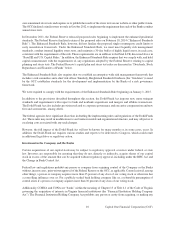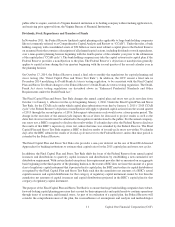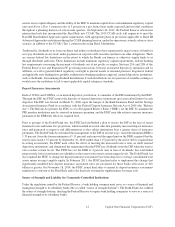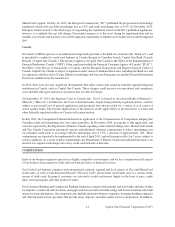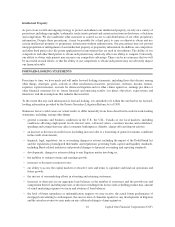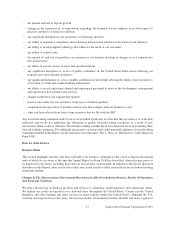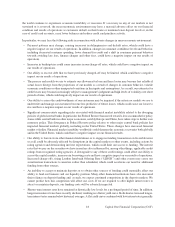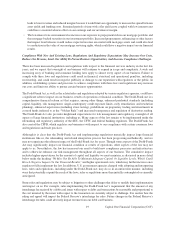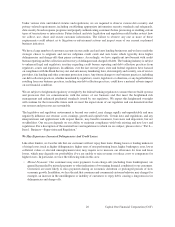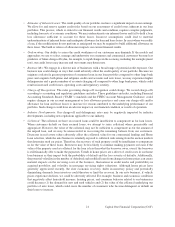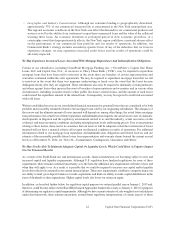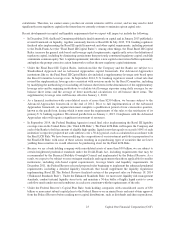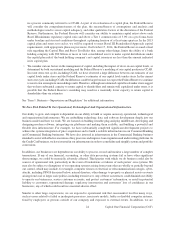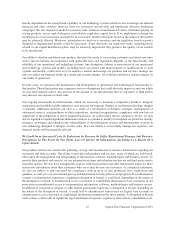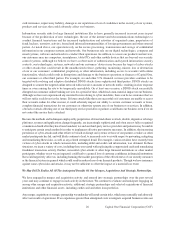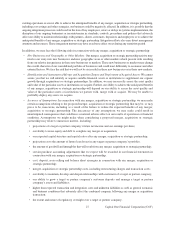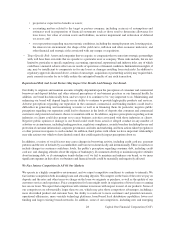Capital One 2014 Annual Report Download - page 41
Download and view the complete annual report
Please find page 41 of the 2014 Capital One annual report below. You can navigate through the pages in the report by either clicking on the pages listed below, or by using the keyword search tool below to find specific information within the annual report.leads to lower revenue and reduced margins because it would limit our opportunity to increase the spread between
asset yields and funding costs. Sustained periods of time with a flat yield curve coupled with low interest rates
could have a material adverse effect on our earnings and our net interest margin.
• The low interest rate environment also increases our exposure to prepayment risk in our mortgage portfolio and
the mortgage-backed securities in our investment portfolio. Increased prepayments, refinancing or other factors
that impact loan balances would reduce expected revenue associated with mortgage assets and could also lead
to a reduction in the value of our mortgage servicing rights, which could have a negative impact on our financial
results.
Compliance With New And Existing Laws, Regulations And Regulatory Expectations May Increase Our Costs,
Reduce Our Revenue, Limit Our Ability To Pursue Business Opportunities, And Increase Compliance Challenges.
There has been increased legislation and regulation with respect to the financial services industry in the last few
years, and we expect that oversight of our business will continue to expand in scope and complexity. A wide and
increasing array of banking and consumer lending laws apply to almost every aspect of our business. Failure to
comply with these laws and regulations could result in financial, structural and operational penalties, including
receivership, and could result in negative publicity or damage to our reputation with regulators or the public. In
addition, establishing systems and processes to achieve compliance with these laws and regulations may increase
our costs and limit our ability to pursue certain business opportunities.
The Dodd-Frank Act, as well as the related rules and regulations adopted by various regulatory agencies, could have
a significant adverse impact on our business, results of operations or financial condition. The Dodd-Frank Act is a
comprehensive financial reform act that requires, among other things, enhanced prudential standards (including
capital, liquidity, risk management, single-counterparty credit exposure limits, early remediation, and resolution
planning), enhanced supervision (including stress testing), prohibitions on proprietary trading and investments in
covered funds (referred to as the “Volcker Rule”) and increased transparency and regulation of derivatives trading.
The Dodd-Frank Act also provides heightened expectations for risk management and regulatory oversight of all
aspects of large financial institutions, including us. Many aspects of the law remain to be implemented under the
rulemaking and regulatory authority of the SEC, the CFTC and federal banking regulators. The Dodd-Frank Act
also created the CFPB, which regulates our businesses with respect to our compliance with certain consumer laws
and regulations and trade practices.
Although it is clear that the Dodd-Frank Act and implementing regulations materially impact large financial
institutions like us, the rulemaking and related interpretive process has been progressing methodically, and we
may not experience the ultimate impact of the Dodd-Frank Act for years. Though some aspects of the Dodd-Frank
Act may significantly impact our financial condition or results of operations, other aspects of the law may not
apply to us. Nevertheless, the law has increased our need to build new compliance processes and infrastructure
and to otherwise enhance our risk management throughout all aspects of our business. The cumulative impact
includes higher expectations for the amount of capital and liquidity we must maintain, as discussed in more detail
below under the heading “We May Not Be Able To Maintain Adequate Capital Or Liquidity Levels, Which Could
Have A Negative Impact On Our Financial Results,” and higher operational costs, which may further increase once
regulators fully implement the law. In addition, U.S. government agencies charged with adopting and interpreting
laws, rules and regulations, including under the Dodd-Frank Act, may do so in an unforeseen manner, including
ways that potentially expand the reach of the laws, rules or regulations more than initially contemplated or currently
anticipated.
Some rules and regulations may be subject to litigation or other challenges that delay or modify their implementation
and impact on us. For example, rules implementing the Dodd-Frank Act’s requirement that the amount of any
interchange fee received by a debit card issuer with respect to debit card transactions be reasonable and proportional to
the cost incurred by the issuer with respect to the transaction are currently subject to challenge. It is unclear how the
ruling and appeal will impact the Federal Reserve’s interchange fee rules. Future changes in the Federal Reserve’s
interchange fee rules could adversely impact revenue from our debit card business.
19 Capital One Financial Corporation (COF)



